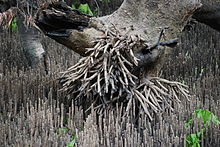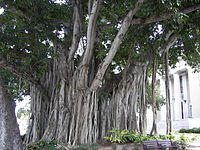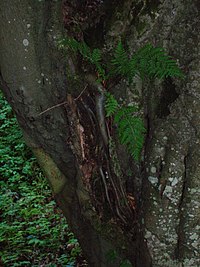Aerial root




Aerial roots are roots above the ground. They are almost always adventitious. They are found in diverse plant species, including epiphytes such as orchids, tropical coastal swamp trees such as mangroves, the resourceful banyan trees, the warm-temperate rainforest rātā (Metrosideros robusta) and pōhutukawa (M. excelsa) trees of New Zealand and vines like Common Ivy (Hedera helix) and poison ivy (Toxicodendron radicans).
Types of aerial roots
This plant organ that is found in so many diverse plant families has different specializations that suit the plant habitat. In general growth form, they can be technically classed as negatively gravitropic (grows up and away from the ground) or positively gravitropic (grows down toward the ground).[1]
Aerial roots as supports
Non-parasitic ivy are vines that use their aerial roots to cling to host plants, rocks, or houses. Prop roots form on aerial stems and grow down into the soil to brace the plant, e.g. maize and screw pines (Pandanus species).
"Stranglers"
The Banyan tree (Ficus sp.) is an example of a strangler fig that begins life as an epiphyte in the crown of another tree. Its roots grow down and around the stem of the host, their growth accelerating once the ground has been reached. Over time, the roots coalesce to form a pseudotrunk, which may give the appearance that it is strangling the host.[2] Another strangler that begins life as an epiphyte is the Moreton Bay Fig (Ficus macrophylla) of tropical and subtropical eastern Australia, which has powerfully descending aerial roots. In the subtropical to warm-temperate rainforests of northern New Zealand, Metrosideros robusta, the rātā tree, sends down aerial roots down several sides of the trunk of the host. From these descending roots, horizontal roots grow out to girdle the trunk and fuse with the descending roots. In some cases the "strangler" outlives the host tree dies, leaving as its only trace a hollow core in the massive pseudotrunk of the rātā.
Pneumatophores
These specialized aerial roots enable plants to breathe air in habitats that have waterlogged soil. The roots may grow down from the stem, or up from typical roots. Some botanists classify these as aerating roots rather than aerial roots, if they come up from soil. The surface of these roots are covered with lenticels which take up air into spongy tissue which in turn uses osmotic pathways to spread oxygen throughout the plant as needed. Black mangrove is differentiated from other mangrove species by its pneumatophores.
Fishermen in some areas of Southeast Asia make corks for fishing nets by shaping the pneumatophores of Sonneratia caseolaris into small floats.[3]
Haustorial roots
These roots are found in parasitic plants, where aerial roots become cemented to the host plant via a sticky attachment disc before intruding into the tissues of the host. Mistletoe is a good example of this.
Propagative roots
Adventitious roots usually develop from plantlet nodes formed via horizontal, aboveground stems, termed stolons, e.g. strawberry runners and spider plant.
Some leaves develop adventitious buds, which then form adventitious roots, e.g. piggyback plant (Tolmiea menziesii) and mother-of-thousands (Kalanchoe daigremontiana). The adventitious plantlets then drop off the parent plant and develop as separate clones of the parent.
See also
References
- ^ UCLA Botany glossary page - Roots
- ^ "Epiphytes - adaptations to an aerial habitat". Royal Botanic Gardens, Kew.
- ^ Wild Singapore - Berembang Sonneratia caseolaris
